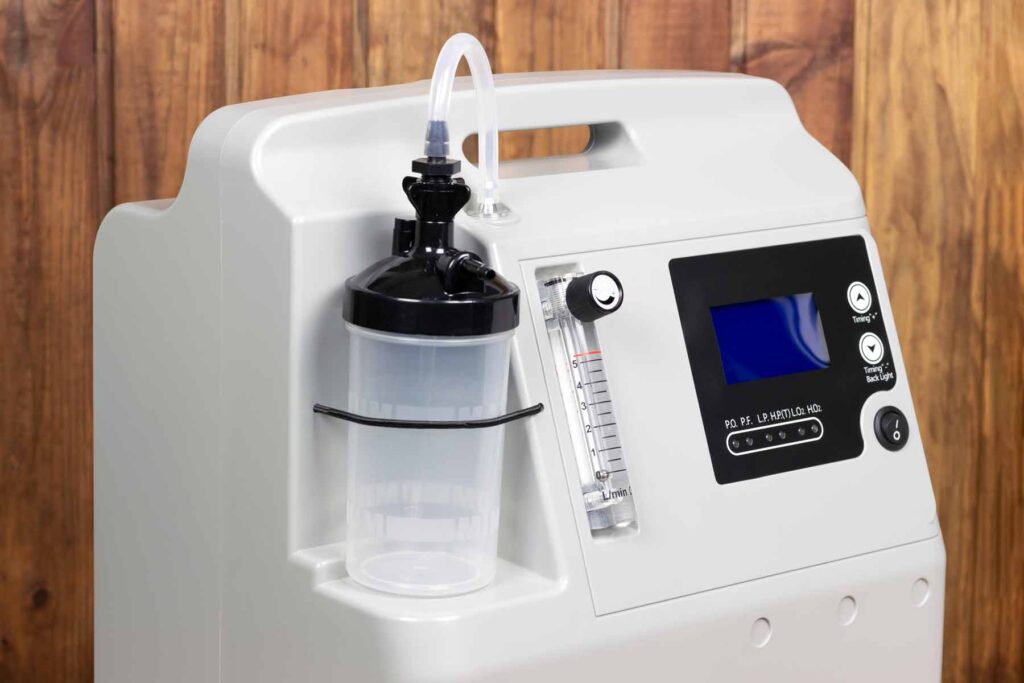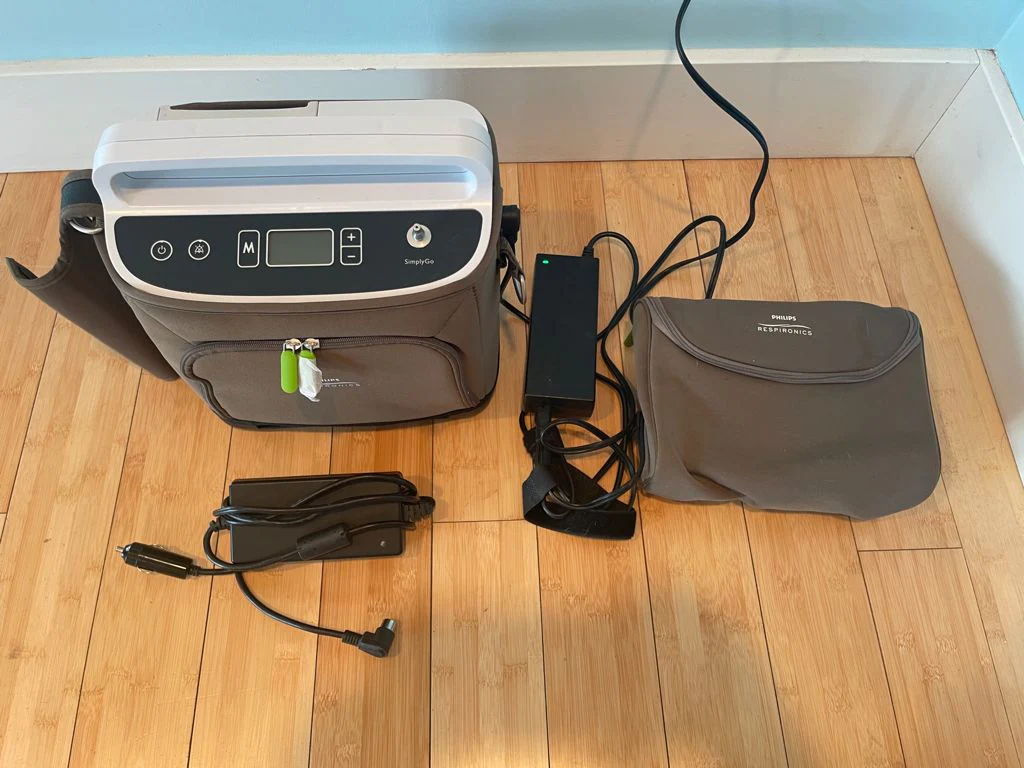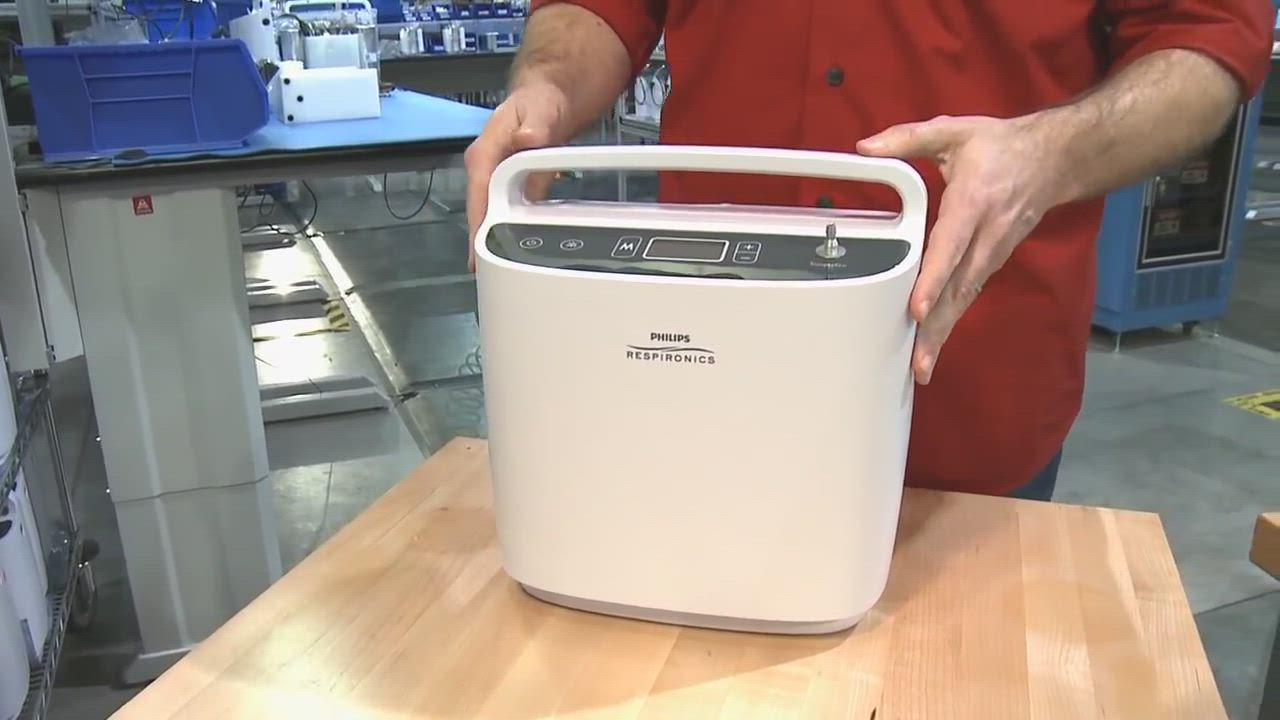What Are Oxygen Concentrators and How Do They Work?
Oxygen concentrators extract and concentrate oxygen from ambient air to deliver therapeutic-grade oxygen for breathing. The atmospheric air we breathe contains approximately 20% oxygen and 78% nitrogen, with trace amounts of other gases.
How Does an Oxygen Concentrator Work?
Here’s a breakdown of the process:
- Air Intake: The device draws in room air through an intake filter.
- Compression: A compressor pressurises this air.
- Filtration: The pressurised air is directed through a series of specialised molecular sieve beds containing zeolite crystals. These crystals act as selective filters, trapping larger nitrogen molecules while allowing smaller oxygen molecules to pass through freely.
- Storage: The concentrated oxygen collects in a storage tank, where it reaches purity levels of 87-95%.
- Flow Regulation: The device regulates the flow rate of the concentrated oxygen.
- Delivery: The oxygen-enriched air is delivered through an outlet connection.
How Do Users Receive Oxygen?
Users receive the concentrated oxygen via either:
- Nasal cannulas – lightweight tubes with prongs that fit into the nostrils
- Face masks – covering both nose and mouth for higher flow requirements
Continuous Operation for Reliable Delivery
The entire cycle operates continuously, with the device alternating between two sieve beds. While one bed captures nitrogen, the other releases the trapped nitrogen back into the atmosphere through a venting system. This alternating process ensures uninterrupted oxygen delivery, making these machines reliable for home use without requiring oxygen tank refills.
What Factors Should Buyers Consider When Choosing an Oxygen Machine for Home Use?
Selecting the right oxygen machine for home use requires evaluating several critical specifications that directly impact daily comfort and medical effectiveness. The decision between a portable or stationary unit forms the foundation of choosing the most suitable oxygen concentrator model, as each option caters to different lifestyle and mobility needs.
1. Oxygen Output Levels
Oxygen output levels determine whether the device meets prescribed medical requirements. Flow rates typically range from 0.5 to 10 litres per minute, with most home users requiring between 1-5 LPM. Verify the concentrator delivers consistent oxygen purity at your prescribed flow rate, as some models struggle to maintain 90%+ concentration at higher settings.
2. Portability versus Stationary Units
Portability versus stationary units presents a trade-off between mobility and power. Portable concentrators weigh 2-7 kg and enable outdoor activities, whilst stationary models offer higher oxygen output and unlimited runtime when plugged in. Consider your activity level and whether you need oxygen therapy exclusively at home or during errands and travel.
3. Power Source Options
Power source options significantly affect home-use considerations. Battery-powered portables provide 2-13 hours of operation depending on configuration, whilst plug-in units require reliable mains electricity. Dual-power models offer flexibility but cost more upfront.
4. Noise Levels
Noise levels range from 31 to 60 decibels across different oxygen machine features. Quieter models (under 40 dB) suit bedroom use and light sleepers, though they often sacrifice portability or output capacity.
5. Maintenance Requirements
Maintenance requirements vary considerably—some units need weekly filter cleaning whilst others operate for months between services.
How Does Battery Life Affect the Usability of Oxygen Concentrators at Home?
Oxygen concentrator battery life directly determines how long you can move freely without being tethered to a power outlet. Single-battery models typically provide two to six hours of operation, whilst double-battery configurations extend this range to five to thirteen hours depending on your flow rate settings.
The portable oxygen machine duration becomes critical during outdoor activities, medical appointments, or unexpected power outages. A patient requiring continuous oxygen therapy at 2 litres per minute will drain batteries faster than someone using pulse-dose delivery at lower settings. Double-battery systems offer peace of mind for extended trips, allowing users to maintain their oxygen therapy whilst attending family gatherings or running errands without anxiety about power depletion.
Battery capacity impact extends beyond convenience to safety considerations. Users living in areas prone to power cuts need sufficient battery backup to bridge gaps until electricity returns or alternative arrangements can be made. Portable units with swappable batteries provide flexibility, enabling you to carry charged spares for all-day independence.
Stationary plug-in concentrators eliminate battery concerns entirely through continuous mains operation. These units suit patients who primarily stay at home and require 24/7 oxygen therapy. The trade-off involves reduced mobility within the home, though longer tubing can provide reasonable movement between rooms whilst maintaining consistent oxygen delivery without interruption.
How Much Oxygen Output Is Needed Based on Medical Requirements?
Oxygen output levels depend entirely on your specific medical condition and prescribed treatment plan. Healthcare providers determine the appropriate supplemental oxygen dosage through blood oxygen saturation tests and ongoing monitoring of your respiratory function.
Patient conditions fall into two distinct categories that influence oxygen therapy requirements:
Short-term users typically need oxygen concentrators during recovery from surgery, pneumonia, or acute respiratory infections. These individuals might use supplemental oxygen for several weeks to months until their lung function improves. Usage patterns often involve intermittent therapy during specific activities or rest periods.
Long-term users manage chronic conditions like COPD, pulmonary fibrosis, or severe asthma. These patients require consistent oxygen therapy as part of their daily medical routine.
Recommended Daily Usage Patterns
Medical professionals commonly prescribe two main usage schedules:
- 15 hours daily: Suitable for moderate oxygen needs, allowing flexibility for activities whilst maintaining adequate blood oxygen levels
- 24/7 continuous use: Required for severe respiratory conditions where blood oxygen levels drop dangerously without constant supplementation
Your doctor will establish specific flow rates measured in litres per minute (LPM), typically ranging from 0.5 to 5 LPM for home concentrators. These settings directly impact which models suit your medical needs when selecting from the Best Oxygen Machines for Home Use: A Practical Buyer’s Guide options. Regular follow-up appointments ensure your oxygen therapy remains effective as your condition evolves.
It’s important to note that the required oxygen output is not just a random figure; it is meticulously calculated based on various factors including weight, height, age, and overall health condition. This detailed approach ensures that the prescribed amount aligns perfectly with the patient’s unique needs, thus optimizing the effectiveness of the therapy. For a deeper understanding of how these calculations are made and the factors influencing them, you can refer to this comprehensive resource on medical guidelines for supplemental oxygen usage. Read more about Oxygen supplement for aged care.

What Are the Benefits and Limitations of Using Oxygen Machines at Home?
Home oxygen concentrators transform daily life by eliminating frequent hospital visits and allowing patients to manage their respiratory needs independently. Benefits home oxygen concentrators provide include enhanced mobility with portable models, enabling users to maintain social connections, run errands, and participate in activities they enjoy without being tethered to a medical facility.
Portable units weigh between 2-5 kg, making them easy to carry in backpacks or shoulder bags. This freedom supports mental wellbeing alongside physical health, as patients maintain their routines and relationships. The convenience extends to overnight use, where quiet operation allows uninterrupted sleep whilst receiving necessary oxygen therapy.
Limitations oxygen machines home use present practical considerations that require planning. Stationary concentrators generate noise levels between 40-60 decibels—comparable to normal conversation—which some users find disruptive during quiet activities or sleep. The devices demand regular maintenance, including weekly filter cleaning and annual professional servicing to maintain efficiency.
Battery-powered models require charging discipline; users must plan outings around battery life or carry spare batteries. Power consumption adds to electricity bills, with stationary units running continuously for 24/7 users. Space requirements also matter—concentrators need adequate ventilation and cannot be placed against walls or in enclosed cupboards. Some patients experience nasal dryness from concentrated oxygen flow, though humidifier attachments address this issue effectively.
Which Are Some Top-Rated Oxygen Machines Suitable for Home Use?
The best home oxygen concentrators 2024 market offers several standout models that excel in different areas. The Inogen One G5 consistently ranks among top rated oxygen machines home use due to its lightweight design (2.2 kg) and impressive battery life of up to 13 hours with a double battery. Its quiet operation at 38 decibels makes it ideal for users who prioritise discretion during social activities.
The Philips Respironics SimplyGo Mini appeals to active individuals seeking portability without sacrificing oxygen delivery. This unit provides pulse-dose settings from 1-5 and weighs only 2.3 kg, making it manageable for daily errands and travel. Battery performance reaches approximately 4.5 hours on setting 2, suitable for moderate outings.
For stationary needs, the DeVilbiss 525DS delivers reliable continuous flow oxygen up to 5 litres per minute. Its robust construction and low maintenance requirements make it dependable for 24/7 home use, though its 14 kg weight limits mobility.
Selecting the right model requires matching specifications to your lifestyle:
- Active users: Prioritise lightweight portable units with extended battery life
- Home-based users: Consider stationary models with continuous flow capability
- Noise-sensitive individuals: Look for units operating below 40 decibels
- Frequent travellers: Choose FAA-approved portable concentrators with multiple battery options
Your healthcare provider’s prescribed flow rate and usage schedule should guide your final decision, ensuring the device meets both medical requirements and daily routine demands.
How Can Users Maintain Their Oxygen Machines to Ensure Longevity and Safety?
Proper maintenance extends device lifespan and ensures safe, effective oxygen delivery. Regular cleaning and inspection prevent equipment failures that could compromise respiratory therapy.
Weekly Cleaning Routines
Weekly cleaning routines form the foundation of maintaining oxygen concentrators. Wipe external surfaces with a damp cloth to remove dust accumulation. Clean air intake filters according to manufacturer specifications—most require weekly washing with mild soap and water, followed by complete air-drying before reinstallation. Replace disposable filters monthly or as recommended.
Attention to Nasal Cannulas and Tubing
Nasal cannulas and tubing demand attention too. Replace cannulas every two weeks and longer oxygen tubing every three to six months to prevent bacterial growth and maintain proper oxygen flow.

Professional Servicing Schedules
Professional servicing schedules vary by model but typically occur annually. Qualified technicians inspect internal components, test oxygen purity levels, and verify pressure settings match prescribed requirements. Document all service visits to track maintenance history.
Safety Guidelines for Home Oxygen Machines
Safety guidelines for home oxygen machines include:
- Keep devices at least 1.5 metres from heat sources, open flames, and electrical appliances
- Ensure adequate ventilation around the unit—never cover air vents
- Store backup batteries in cool, dry locations away from direct sunlight
- Post “No Smoking” signs prominently in rooms where oxygen is used
- Check power cords regularly for fraying or damage
These safety tips for home oxygen machines protect both users and household members whilst maximising equipment performance.
FAQs About Best Oxygen Machines for Home Use: A Practical Buyer’s Guide
An oxygen concentrator extracts oxygen from the air and delivers purified oxygen for medical use, helping people with low blood oxygen levels.
2. How does an oxygen concentrator work?
It draws in room air, removes nitrogen using filters and sieve beds, and supplies oxygen-rich air through a nasal cannula or face mask.
3. What oxygen purity do concentrators provide?
Most concentrators deliver 87–95% pure oxygen, depending on the model and settings.
4. What’s the difference between portable and stationary oxygen concentrators?
Portable units are lightweight and battery-powered for mobility, while stationary units provide continuous oxygen flow for long-term home use.
5. How long does a portable oxygen concentrator battery last?
Battery life ranges from 2 to 13 hours, depending on the model, settings, and whether a single or double battery is used.
6. What factors should I consider when buying an oxygen concentrator?
Key factors include oxygen output, portability, power source, noise level, and maintenance requirements.
7. How much oxygen output is needed for medical use?
Home concentrators typically deliver 0.5–10 litres per minute (LPM), with most users needing 1–5 LPM based on doctor recommendations.
8. What are the benefits of using an oxygen machine at home?
They provide greater independence, mobility, and convenience, allowing continuous oxygen therapy without refilling tanks.
9. How should I maintain my oxygen concentrator?
Clean filters weekly, replace tubing regularly, and schedule annual professional servicing to ensure safe and efficient operation.

